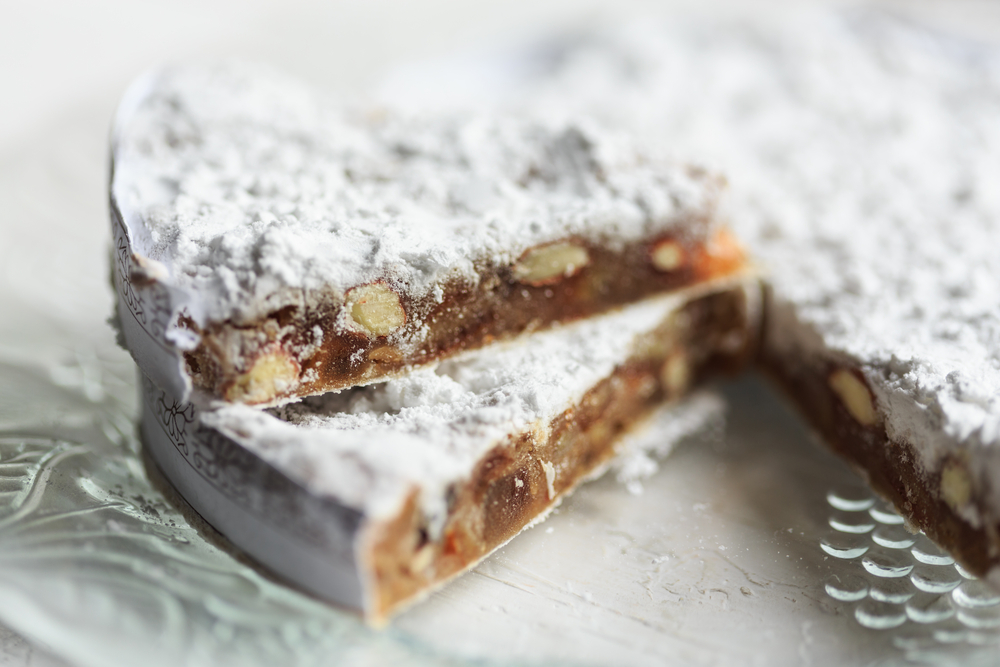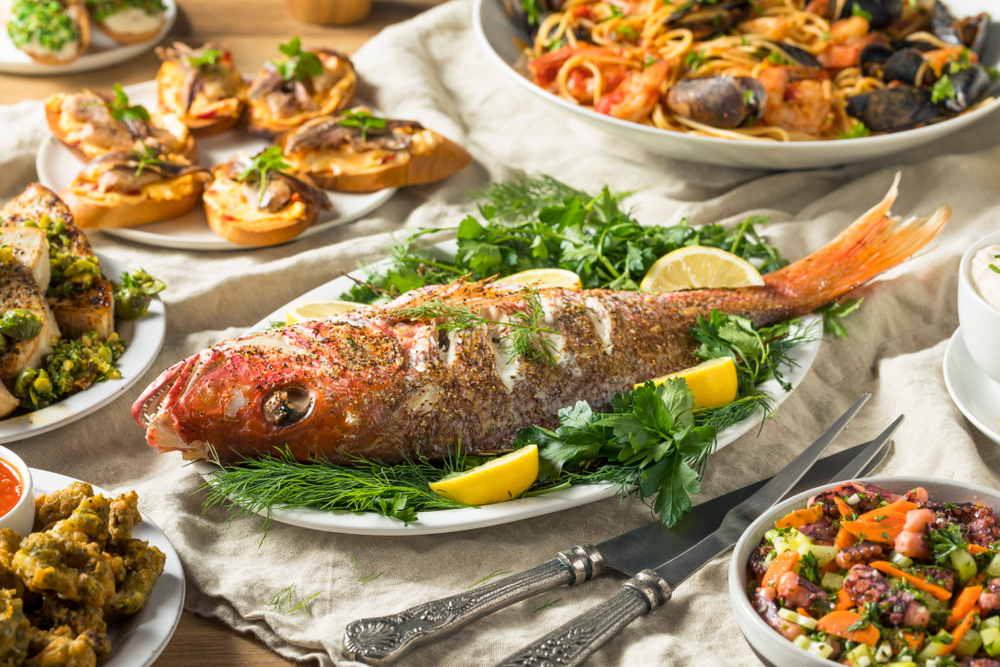What do Italians eat at Christmas?
On the night before Christmas, when people’s attentions are turning to timings for tomorrow’s Christmas dinner, our thoughts have turned to Italian food!
As you would expect, food is a big part of the Italian Christmas celebrations. But, just as at other times of the year, when you will find that each region has its own specialities, there is no simple answer to what Italians eat at Christmas. It varies from north to south and from east to west. It’s certanly not like in the UK where the vast majority opt for one dish – turkey with all the trimmings! Instead, each region will do things sightly differently!
What is for certain is that it’s certainly a time to enjoy some of Italy’s finest sweet treats. The most famous of Italy’s Christmas cakes is definitely the panettone. There are a number of stories surrounding the origins of panettone. We do know for a fact that ancient Romans enjoyed panem triticum, bread sweetened with eggs and raisins. However, another story claims that it was founded in Milan in the 9th century and subsequently became the official Christmas treat in 1395 when a decree stated that all bakeries in the city should make pan de’ sciori or pan del ton, a sweetened white loaf, for everyone to enjoy at Christmas.
However, one of our favourite stories (which could well be more rooted in fiction than fact), is that a kitchen hand in the court of Ludovico Il Moro, the Duke of Milan, accidentally burnt the duke’s pudding on Christmas Eve and so, trying to make amends and dig himself out of a rather large hole, he mixed the leftover dough with sugar, eggs, candied fruits and raisins and baked the very first panettone! If this story is to be believed, the panettone went on to become the official Christmas dessert and the kitchen hand, Toni, became a firm favourite in the court!
Whatever its exact origins, what we do know for sure is that these days, panettone has made its way into many other cultures and is found in many countries across the world. It is made with flour, eggs, butter, raisins and candied fruit. In Italy it’s a tradition to give a panettone to the host of any get-together and that’s certainly something we think should be encouraged elsewhere too!

Almost as well known is Tuscany’s panforte. Again, this dessert dates back hundreds of years but this time has its origins in Siena. Most agree that it was invented in the 13th century by a nun, Suor Leta, who was tasked with preparing the sweet treats for the banqueting tables of the Tuscan aristocracy. Certainly, it was being sold commercially by the end of the 14th century to pilgrims making their way along the Via Francigena. However, the panforte we see today may differ from the original. Many versions served today have the name Panforte Margherita, reflecting the visit of the King of Italy to Siena in 1879, accompanied by the queen consort Margherita di Savoia.
Originating further north in Verona is pandoro, a sweet bread which translates literally as ‘golden bread.’ The story goes that some of the earliest versions of this sweet treat were made for wealthy households during the era of the Venetian Republic and would have been served covered in gold leaf! Baked in an eight pointed star-shaped pan, these days it is often dusted with icing sugar to resemble the snowy peaks of the Italian Alps. Taste wise, it’s not dissimilar to a French brioche. We like it best served with a dollop of cream made by mixing eggs with sugar, mascarpone cheese and a smattering of Cognac!
But, as with all Italian food, you’ll find that wherever you spend Christmas in Italy, each region will have its own unique speciality. So, alongside the pandoro, panettone and panforte, in Campania you’ll find struffoli (small balls of baked or fried dough served with candied fruit, sugar and honey) whilst in Sicily you’ll find buccellati. In Calabria, there will be nepitelle, in Puglia cartellate and in Lazio pangiallo. In Bologna, look out for the panspeziale made with almonds, pine nuts, sultanas, aniseed seeds, honey, chocolate, candied fruit and rum, whilst in Ferrara, you’ll be feasting on panpatato instead. And in Le Marche, you’ll find that their traditional Christmas cake is frustingolo, made with dried figs, sultanas, candied fruit and spices with the addition of cocoa and coffee. The list goes on…
Christmas Eve in Italy
Whilst the food may vary from region to region and from house to house, December 24 throughout Italy is usually a time for families to spend together. Traditionally, this is the evening when Italians will enjoy the Festa dei Sette Pesci (Feast of the Seven Fishes), commonly known as La Cena della vigilia, Il Cenone or La vigilia di Natale in Italy. As the name suggests, the emphasis in this meal is not on meat but on fish and seafood, reflecting the Roman Catholic tradition which forbids the eating of meat on the evening before a religious holiday.

However, it’s not seven different types of fish but more typically a couple of different types of fish prepared seven different ways. The reason why the number seven is chosen is most likely to do with Catholic symbolism. The Bible is full of references to the number seven – the seven sacraments, the seven deadly sins and the seven days it took for the Creation are all notable examples of the number in Roman Catholic history.
The Festa dei Sette Pesci is a feast that originates in the South of Italy which is traditionally poorer but where, thanks to its long coastline, there is plenty of good quality, cheap seafood to enjoy. The 24th of December – The Vigil of the Nativity of the Lord in the Roman Catholic calendar – has historically been a day for Roman Catholics to fast and abstain from indulging, however worshippers have always been allowed to break this fast in the evening hence the chance to enjoy a big dinner with family at night. The emphasis is very firmly on abundance! Celebrations will usually last well into the evening until families eventually make their way to midnight mass.
Christmas Day in Italy
As in so many other countries, families in Italy will enjoy a long, celebratory dinner together on Christmas Day. It’s not unusual for the meal to last for several hours and it’s typically a much heavier meal than on Christmas Eve. Christmas lunch often begins with classic plates of antipasti followed by a plate of pasta. The latter will vary by region. In Southern and Central Italy, it’s more commonly a baked pasta dish whilst in the North, you’ll find more households enjoy lasagna or filled pasta such as ravioli. After that, Italians usually enjoy a meat dish – often roast veal, chicken, lamb, sausages or braised beef. And, of course, the meal finishes with dessert!
Boxing Day
Saint Stephen’s Day – Festa di Santo Stefano – on 26 December is a public holiday in Italy and it’s definitely a chance for Italians to continue the festive celebrations together. If there are no ‘new’ guests, families and friends will usually meet again to use up the delicious leftovers from the previous day. If new dishes are rustled up, the fare will typically be much less elaborate than on the previous two days but may include some less traditional pasta dishes. Many people also opt to eat out in a restaurant on the 26th, to make a change from being at home.
Whatever you have on your festive menus this Christmas, we hope you enjoy a wonderful time with family and friends.


